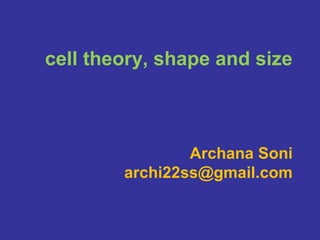
The cell-theory
- 1. cell theory, shape and size Archana Soni archi22ss@gmail.com
- 2. 1665 – Robert Hooke Observed cells in cork. Coined the term "cells”. Cork Cells
- 3. 1673- Anton van Leeuwenhoek Created a powerful microscope
- 4. 1827-33 - Robert Brown -noticed that pollen grains in water jiggled around called “Brownian motion” -discovered the nucleus Nucleus Human Cheek Cell
- 5. 1838 - Matthias Schleiden A botanist who concluded that all plants are made of cells. Typical Plant Cell
- 6. 1839 - Theodor Schwann A zoologist who concluded that all animals are made of cells. Nerve Cells
- 7. 1855 - Rudolph Virchow A physician who did research on cancer cells and concluded “Omnis cellula e cellula”. “All cells are from other pre-existing cells.”
- 8. Cell theory • Formally established by Theodor Schleider and Matthias Schwann in 1839, cell theory (or cell doctrine) is the most basic tenet underlying the field of biology. • Cell Theory is one of the basic principles of biology. Credit for the formulation of this theory is given to German scientists Theodor Schwann, Matthias Schleiden, and Rudolph Virchow.
- 9. The Cell Theory The Cell Theory states: •All living organisms are composed of cells. They may be unicellular or multicellular. •The cell is the basic unit of life. •Cells arise from pre-existing cells. (They are not derived from spontaneous generation.) The modern version of the Cell Theory includes the ideas that: •Energy flow occurs within cells. •Heredity information (DNA) is passed on from cell to cell. •All cells have the same basic chemical composition.
- 11. Cells are Diverse… Cell Size and Shape •The shapes of cells are quite varied with some, such as neurons, being longer than they are wide and others such as erythrocytes (red blood cells) being equidimensional. Cell shape varies depending both on function and surface area requirements.
- 12. The cell size is limited by the certain factors and that include surface area to volume ratio, the nucleo-cytoplasmic ratio, the fragility of the cell membrane and the structures that hold the cell together. Each of these factors works in conjunction to limit the ability of the cell to support a larger size •Surface area to volume ratio Cells diffuse nutrients and oxygen across their cell membrane to function properly and obtain proper nutrition. Cells need a high surface area to volume ratio, but the volume increases faster than surface area as cells grow larger. Lets see the examples of formulae of simple shapes. (where r is the length of each side of the cube) (where r is the radius of the sphere, The diameter (d) of the sphere is twice the radius so the above could be re-written in terms of diameter using the relationship d=2r) Using the above formulae, it is easy to express the ratios of surface area to volume for these very simple shapes: Surface area / Volume ratio for a cube = 6/r Surface area / Volume ratio for a sphere = 3/r = 6/d
- 13. Why Are Cells So Small? • Transport- Cell volume to surface area ratios favor small size. • Control- Nucleus to cytoplasm consideration. • Metabolic requirements- ……..we’ll come back to this later.
- 14. How small can a cell be? Mycoplasmas - bacteria that are 0.1 to 1.0 µm. (1/10 the size of regular bacteria). Note: 1.0 µm = one millionth of a meter
- 15. Cell Types Prokaryotes- simple cells that do not have internal membranes example = bacteria Eukaryotes- more complex cells that do have internal, membrane- bound structures examples = plants and animals
- 16. Timeline Prokaryotic Organisms: First appeared 3.5 BYA include bacteria and cyanobacteria Eukaryotic Organisms: First appeared 2.0 BYA include protists, fungi, plants and animals
- 17. Key Differences: Prokaryotes • Lack a nucleus and other membrane bounded structures. • Have small ribosomes • DNA is not organized into chromosomes • Flagella are not made of microtubules and does not have a 9+2 structure • Cell walls are made of peptidoglycan, not cellulose Eukaryotes • Have a nucleus and other membrane bounded structures. • Have large ribosomes • DNA is organized into chromosomes • Flagella are made of microtubules and have a 9+2 structure • Cell walls are made of cellulose
